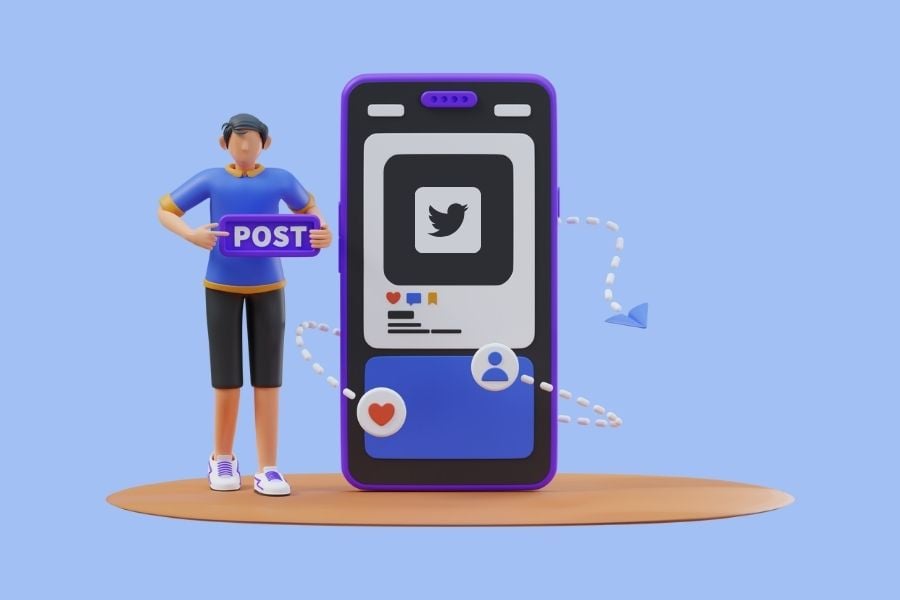As a small business owner, digital marketing statistics can give your content marketing strategy a competitive edge in 2023.
You know it’s difficult balancing content marketing and sales with actually creating your product or delivering your service.
Plus, time and resources are a serious concern for you. Right?
Well, no worries. We’ve got you.
Using these digital statistics you can identify the best channels and tactics for your strategy. From content marketing to closing sales, the statistics in this post will help guide you toward the best use of your time and resources.
Okay?
So, let’s dive right in!

Digital Marketing Statistics: Not Just for the Big Guys Anymore
It’s the 21st century. This means, along with traditional marketing, businesses must have an online presence to meet their potential.
Small businesses are no exception.
But it’s not enough to slap a website together and call it a day. The internet, technology, consumer expectations and habits are evolving daily.
So too, must your digital marketing strategy.
And to keep pace, you have to have (and understand) data specific to your industry, business, and target market.
In other words, you need digital marketing statistics to launch a digital marketing strategy that converts.
Not totally convinced?
Here’s how using digital marketing statistics can help:
- It highlights which marketing channels and markets should be prioritized based on statistics regarding what has proven successful in a prior campaign
- It gives you a competitive boost — and often helps you get ahead of your competitors
- It simplifies identifying market patterns and trends so you can spend more time strategizing than researching
And while ultimately, you’ll want to make sure you gather statistics specific to your industry, we’ve collected 100+ digital marketing statistics to get you started.
1. Content Marketing Statistics

Here’s what you need to know about content marketing strategy:
- Video was the primary form of content being created in 2022, followed by blogs and images. (HubSpot, 2022)
- 46% of businesses plan to increase their inbound marketing content creation spending in 2023. (Content Marketing Institute, 2022)
- 3% of marketers publish content at least weekly. (GrowthBar, 2022)
- 83% of marketers say it’s better to focus on quality rather than quantity of content, even if it means posting less often. (Hubspot, 2022)
- Blog posts with videos get 157% more search traffic than those that don’t. (Wyzowl, 2021)
2. SEO Statistics
What about SEO?
- The top three Google search engine results combined receive 54.4% of all clicks. (Backlinko, 2022)
- The #1 organic result on Google gets almost 20x the traffic of the top ad (39.6% vs. 2.1%). (First Page Sage, 2022)
- The highest e-commerce conversion rates are achieved when the page loads in under two seconds. (Portent, 2022)
- By 2025, around 72.6% of internet users will only use their smartphones to go online. (Source: CNBC, 2022)
- The industries that dedicate the most marketing budget to SEO are Law, Travel, and Higher Education. (First Page Sage, 2022)
- 90% of searches are done on Google (search, image search, shopping, etc.). (Outerbox, 2023)
3. Email Marketing Statistics
And then there’s email marketing:
- For every $1 spent on email marketing, markets can expect to see around $36 in return. (Litmus, 2022)
- The average campaign email is less than 500 words. (AWeber, 2022)
- Abandoned cart emails and emails sent after a customer adds an item to their cart have the highest conversion rates at 18.54% and 24.58%, respectively. (Barlliance, 2022)
- Monday’s average open rate is 22%, the highest of the week. (Campaign Monitor, 2022)
- Sending one relevant email newsletter per week will show a 33% higher open rate than if you sent two or more emails. (GetResponse, 2022)
- Of those who subscribe to email lists, 42.3% want to receive discounts or sales promotions (OptinMonster, 2022)
4. Lead Generation Statistics
How can you cultivate new customers this year?
- 66% of markets generate leads from social media after spending only six hours per week on social media marketing. (Social Media Examiner, 2022)
- Despite shrinking overall marketing budgets, 26.5% of CMOs say they’ll increase their budget for marketing technology such as marketing automation tools. (Gartner, 2021)
- 53% of marketers say webinars are the top-of-the-funnel format that generates the most high-quality leads. (Demand Gen Report, 2021)
- Only 33% of marketers use live chat as a conversion tool. (Ruler Analytics, 2021)
- 97% of people ignore cold calls. (Zipwhip, 2019)
- Podcasts, blog posts, and videos are the top three content types for generating awareness and demand. (Content Marketing Institute, 2022)
5. Video Marketing Statistics

Video marketers…saved?…the radio star.
- 93% of brands say they got new customers due to the videos posted on their social media accounts. (Hubspot, 2022)
- 66% of people said they’d prefer to watch a short video to learn about a product or service, while 18% would instead read a text-based article, website, or post. (Elite Content Marketer, 2022)
- 84% of people that watch explainer videos decided to purchase after watching the video. (Hubspot, 2022)
- 87% of businesses are already using video as a digital marketing outlet. (Boast, 2022)
- 83% of markets say that video has helped lengthen the amount of time visitors spend on their website. (Wyzowl, 2022)
- Your website can appear 53x higher on Google if it includes video. (Moovly, 2021)
- 83% of consumers will share video with their friends if it provides content they enjoy (Hubspot, 2022)
- 52% of marketers say videos ranging from one to three minutes long have been most successful for their content marketing (Content Marketing Institute, 2022)
6. Podcast Statistics
The newest player in the game: podcasts.
- 51% of people who listen to 5 or more hours of podcasts per week say they pay more attention to ads on podcasts than ads on other media. (Edison Research, 2022)
- 38% of podcast listeners have bought something that was mentioned on a podcast. (Buzzsprout, 2022)
- 45% of podcast listeners have a household income over $250,000. (Forbes, 2021)
- Podcast advertising makes up 3% of overall ad spend as opposed to 20% on video, 16% on social media, 14% on display, and 13% on search. (Media Post, 2021)
- 56% of podcast listeners say they would recommend a product or service to others after hearing an advertisement on a podcast. (AdResultsMedia, 2022)
- 64% of podcast listeners say they welcome and appreciate advertising on podcasts and are grateful to the brands that support their favorite shows. (Edison Research, 2022)
7. Social Media Marketing Statistics
When it comes to social media marketing, keep the following social media statistics in mind:
- 84% of consumers expect brands to create their own content rather than farming it out to consumers. (Smallbizgenius, 2022)
- 71% of Gen Z-ers prefer to discover new products on social media. (Hubspot, 2022)
- Instagram’s ad reach grew 20.5% YoY compared to Facebook’s 6.5% growth rate. (Hootsuite, 2022)
- Social media marketers’ most common posting frequency is 3-4 times a week. (Hubspot, 2022)
- 71% of consumers who’ve had a positive experience with a brand on a social media platform are likely to recommend that brand to friends and family. (LYFE Marketing, 2022)
- 44% of users shop for products on Instagram weekly (and 28% of those shopping activities are pre-planned. (Instagram, 2021)
- Shoppers on Pinterest have 85% larger shopping carts than buyers on other platforms (and spend twice as much monthly). (Pinterest, 2021)
8. Brand Building Statistics
Let’s talk about the brand, baby.
- 52% of consumers value increased sustainability efforts from brands, an effect of the pandemic’s forced changes in buying habits. (GFK, 2022)
- Branding consistency can increase revenue by 20%. (LucidPress, 2021)
- 46% of consumers will pay more for trusted brands. (Salsify, 2022)
- 69% of consumers will engage with your brand using chatbots. (NetQuid, 2021)
- 41% of brands use influencer marketing to increase brand awareness. (MeltWater, 2021)
- 40% of customers will stick to private-label brands. (McKinsey, 2020)
- Signature brand color boosts brand recognition by 80%. (Reboot, 2022)
9. Voice Search Statistics
Everyone loves the sound of their own voice.
- 41% of adults (and rising) use voice search daily. (DBS Interactive, 2022)
- In the USA, 51% of internet users shop with the help of voice assistance features. (Review42, 2022)
- In 2022, an estimated 33.2 million Americans shopped using a smart speaker. (Wootsuit, 2022)
- 58% of consumers took advantage of voice search to find local business information. (Siteimprove, 2022)
- 28% of people contact the business after doing a voice search. (BrightLocal, 2018)
- Men are three times more likely to do a mobile voice search than women. (Go-Globe, 2018)
- Voice shopping will grow to $40 billion by end-2022. (Invesp, 2022)
- Grocery is the most commonly shopped category through voice. (TechCrunch, 2018)
10. Organic Search Statistics

Who doesn’t love a freebie?
- 61% of B2B marketer stated that SEO and organic traffic generate more leads than any other marketing initiative (including Google ads!). (Hubspot, 2022)
- 86% of people ignore paid banner ads, only clicking on organic search results. (User Guiding, 2021)
- 53% of all trackable website traffic comes from organic search. (BrightEdge, 2021)
- The average organic click-through rate (CTR) the first Google desktop search result gets is 32%. (Advanced Web Ranking, 2022)
- The percentage of pages that get no organic search traffic from Google is 90.63%. (Ahrefs, 2020)
- 51% of shoppers surveyed use Google to research the purchases they plan to make online. (Think With Google, 2022)
- The first five organic results on search engines account for about 67.6% of all clicks. This is more than two-thirds of all clicks. (Zero Limit Web, 2021)
- Organic traffic generated from SEO is 1000% higher than the organic traffic generated from social media. (WebFX, 2022)
11. Online Shopping Statistics
There’s nothing like shopping in your pajamas.
- In 2023, eCommerce sales are expected to account for 20.8% of retail sales worldwide. (Oberlo, 2022)
- 28% of U.S. shoppers use mobile phones while in a physical store to look up discounts, compare prices, and read product reviews. (PYMNTS, 2022)
- 80% of shopping carts are abandoned. (Oberlo, 2022)
- High extra costs, like shipping and tax, are the top reason shoppers abandon carts. (Baymard, 2022)
- Mobile eCommerce is expected to account for 42.9% of eCommerce sales by 2024. (Business Insider, 2022)
- Digital and mobile wallets are the most popular payment methods among online shoppers worldwide, with nearly half (49 percent) of online shoppers choosing to pay with this method. (Oberlo, 2022)
- Physical stores are expected to account for 72% of retail sales by 2024, a drop from 87% in 2022, indicating that the future of retail was, and continues to be, digital. (Zippia, 2022)
12. Customer Experience Statistics
The customer is always right.
- 76% of people will stop doing business with a company after only two poor customer experiences. (Venture Beat, 2022)
- 83% of consumers factor in customer service quality when deciding what to buy. (Khoros, 2021)
- 40% of users who have a negative experience on a brand’s mobile marketing website will go to its competitor. (Outer Box Design, 2022)
- 79% of shoppers expressed interest in auto-replenishment services and subscription models for their frequent purchases at the beginning of 2022. (Wicked Reports, 2022)
- 61% of consumers are willing to pay more to have their products delivered on the same day: but only 51% of retailers offer same-day delivery. (Your Digital Resource, 2022)
- As of 2022, 67% of U.S. shoppers have utilized “curbside pickup” or “buy online, pickup in-store.” By 2025, it is expected that 10% of all sales will be fulfilled this way. (Invesp, 2022)
- 87% of customers spend less or entirely abandon brands that lack effective customer service. (The Future of Commerce, 2022)
- 92% of consumers claim to be willing to buy again from channels that offer easy returns, whereas 79% expect free shipping on returns. (Invesp, 2022)
13. Sales Statistics
To buy or not to buy… is something you never want your customers to wonder…
- 33% of sales reps say they average 2-4 interactions with prospects in the sales process. 26% report 5-7 exchanges. (HubSpot, 2022)
- 86% of consumers will use at least 2 different channels (and 70% will use at least 3) when making a single purchase. (Zippia, 2022)
- 32% of sales professionals offer prospects freemium options, and about 90% of them say it’s moderately to highly effective at turning prospects into paying customers. (HubSpot, 2022)
- 74% of consumers begin product searches on Amazon. (Zippia, 2022)
- Almost 90% of sales professionals try to upsell their customers, and nearly half of companies report up to 30% of their revenue comes from upselling. (HubSpot, 2022)
- More than 25% of sales professionals believe personalization was the most significant change in sales in 2022. (HubSpot, 2022)
14. Social Proof Statistics
My cousin told me that her boyfriend’s sister said…
- 72% of people feel that social proof is more credible than when a brand talks about its products. (Tint, 2022)
- 60% of millennials are more likely to take advice from YouTube influencer marketing than traditional media personalities. (Startup Bonsai, 2022)
- Social selling, or word-of-mouth marketing brings in 5x more sales than paid digital advertising. (Review42, 2022)
- 28% of people say word-of-mouth is the most important factor in strengthening or eroding brand affinity. (Semrush, 2021)
- 96% of unhappy customers don’t complain to the company about a bad experience; however, they share their bad experience with about 9-15 people. (Review42, 2022)
- It takes nearly 40 positive customer experiences to make up for the damage caused by a single negative review. (Writer’s Block Collective, 2022)
- Experts predict that marketers will collectively spend more than 4.5 billion dollars on influencer marketing by 2023. (Statista, 2022)
15. Conversion Rate Optimization (CRO) statistics

And finally, the point of all marketing: driving conversions.
- Full-screen takeover advertisements have the highest conversion rate at 2.4%, with downloadable white paper offerings being the most likely CTA type to convert (1.6%). (First Page Sage, 2021)
- Although mobile is becoming the preferred method of search, mobile marketing has the lowest conversion rating at 2%, compared to 3% for both desktops and tablets (Meet Anshi, 2022)
- 81% of sales don’t happen until after receiving 7 or more communications from businesses. (Lead Pages, 2022)
- There’s an 86% improvement in conversion rates when video content is used on landing pages. (Wish Pond, 2022)
- Companies with 10-15 landing pages get 55% more leads than companies with fewer than 10. (HubSpot, 2022)
- Landing pages have a 160% higher conversion rate than other sign-up forms. Landing pages have an average of 23% conversion, followed by the interactive content Wheel of Fortune (10%), pop-ups (3%), and sign-up boxes (2%). (Omnisend, 2021)
Win the Game With Digital Marketing Statistics
Whether you’re building a content marketing strategy from scratch or simply polishing what you already have, the latest digital marketing statistics can sharpen your focus and help you beat the competition.
Tightening up your strategy also saves your valuable time, resources, and energy.
So take a good look at the channels and tactics you use and how you use them.
These statistics can help you determine what works, what doesn’t, and what you can add (or subtract) from the mix.
Don’t wait, do it today! And make your content marketing strategy one that knocks the socks off your competitors.



